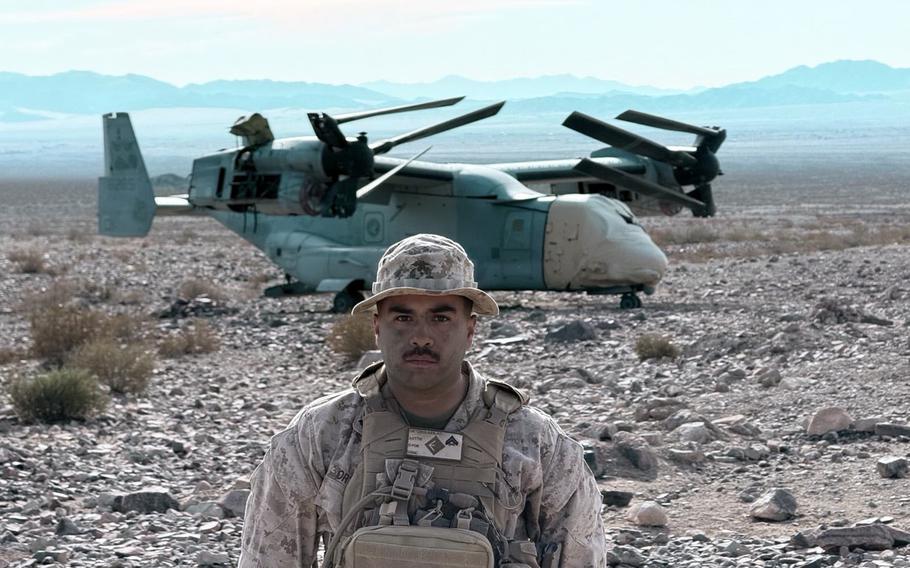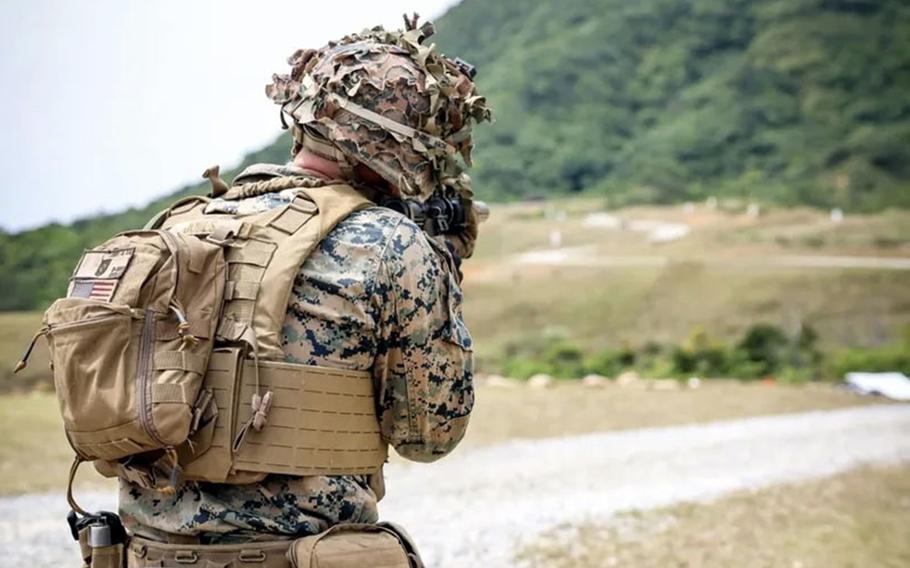
Cpl. Angel Ortiz-Roldan, a machine gunner with Echo Company, 2nd Battalion, 23rd Marines, prepares for an Okinawa deployment in California's Mojave Desert in January 2025. (U.S. Marine Corps)
CAMP SCHWAB, Okinawa — As California-based Reserve Marines trained in the desert in January to prepare for a six-month deployment to Okinawa, a wildfire crept toward their neighborhoods back home.
The Eaton Fire, one of the largest and most destructive in California’s history, started in Eaton Canyon, less than a mile from the Reserve Training Center on Paloma Street in Pasadena, home to 2nd Battalion’s, 23rd Marines’ Headquarters and Services Company.
“And the winds just pushed them down through the neighborhood,” battalion commander Lt. Col. Davis Gooding told Stars and Stripes at Camp Schwab on April 16.
The fire destroyed 9,400 homes and 14,000 acres in neighboring Altadena, coming within two blocks of the Reserve center but sparing battalion members and their immediate families from serious losses.
About a dozen Marine families evacuated temporarily but later returned home safely, Gooding said.
“We’ve certainly focused on providing services for those Marines through Marine Forces Reserve channels, as well as community support,” he said.
The battalion, consisting of about 1,000 Marines, arrived at Schwab in March. Its last deployment to Okinawa was in 2018.
Since 1977, the Unit Deployment Program has rotated U.S.-based infantry battalions to Okinawa for jungle training, exercises with Japanese and South Korean allies, and other activities supporting the III Marine Expeditionary Force’s mission in the Indo-Pacific.
The last full Reserve battalion to deploy to Okinawa was 1st Battalion, 25th Marines in 2020.
Second Battalion includes Golf and Weapons companies headquartered at Naval Weapons Station Seal Beach in Los Angeles; Fox Company from Salt Lake City and Las Vegas; and Echo Company from San Bruno, Calif.
The battalion traces its origins to World War II, when it formed in 1942 with the 23rd Marines and fought in battles at Roi-Namur, Saipan, Tinian and Iwo Jima, and later served during the Iraq War in 2003 and 2009.
Its call sign, the Marshall Battalion, comes from its role in the Marshall Islands campaign of WWII, Gooding said.

A Marine reservist with 2nd Battalion, 23rd Marines shoots at a firing range on Camp Schwab, Okinawa, in this undated photo. (U.S. Marine Corps)
Reserve deployments to Okinawa were more common during the Global War on Terrorism “to relieve the burden on the active-duty force,” Gooding said. They are resuming as the Marine Corps’ Force Design concept shifts the service’s focus to the Indo-Pacific.
“We leverage our civilian experiences … to enhance the military capability of specifically the 4th Marine Regiment,” which the battalion is attached to during the deployment, Gooding said.
Cpl. Angel Ortiz-Roldan, a machine gunner with Echo Company, works as a civilian technician developing new battery technology for electric vehicles and handheld devices at QuantumScape in Santa Cruz, Calif.
That experience, he said, is helpful with things like problem-solving and fixing equipment in the field.
“I handle multimillion dollar machinery to develop things that have never been done before,” he said. “So, with that also comes how we’re going to solve these issues. That mindset that I got from working with other engineers, scientists, is something I’ve brought over to the Marine Corps side.”